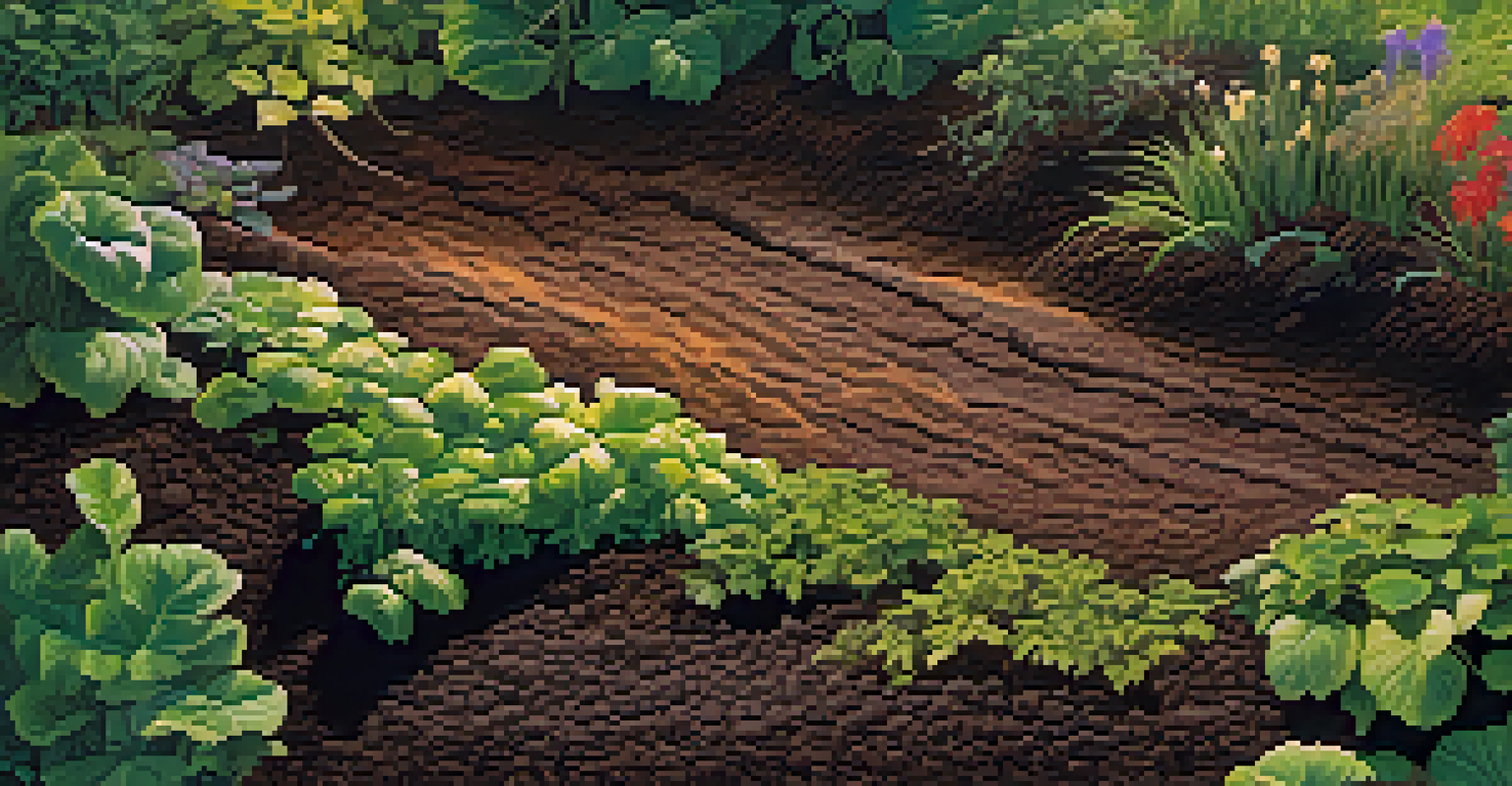The Role of Biodiversity in Permaculture Systems Explained

What is Biodiversity and Why Does it Matter?
Biodiversity refers to the variety of life in a particular ecosystem, including the different species of plants, animals, and microorganisms. It's crucial because it contributes to ecosystem resilience, enabling systems to withstand environmental changes. Just think of it as a diverse toolbox; each tool serves a different purpose, allowing for creative solutions to complex problems.
The diversity of life is the foundation of human existence.
In permaculture, biodiversity is not just a nice-to-have; it’s an essential component. Healthy ecosystems thrive on the interdependence of various species, which can lead to more productive and sustainable systems overall. Imagine a garden where plants support each other instead of competing—this synergy is what biodiversity brings to the table.
Moreover, a rich variety of life can enhance ecosystem services such as pollination, pest control, and soil fertility. When different species work together, they create a balance that minimizes the need for chemical inputs, making permaculture systems more sustainable and self-sufficient.
The Interconnectedness of Species in Permaculture
In permaculture, every element is designed to support others, creating a web of interdependence. This interconnectedness is a core principle of biodiversity, where various species play distinct roles that benefit the entire ecosystem. For example, certain plants can fix nitrogen in the soil, enriching it for other plants that need it.

This relationship can be likened to a well-conducted symphony, where each instrument contributes to a harmonious performance. When one species thrives, it supports others, leading to a flourishing environment that can produce food, habitat, and clean air. By understanding these relationships, permaculture practitioners can design systems that are inherently resilient.
Biodiversity Boosts Ecosystem Health
A diverse range of species enhances resilience, productivity, and sustainability within ecosystems.
Additionally, the diversity of species helps to mitigate the risks associated with pests and diseases. When a single crop is planted in vast quantities, it becomes vulnerable to outbreaks. However, a diverse planting strategy spreads this risk across many species, ensuring that if one suffers, others can still thrive.
Enhancing Soil Health Through Biodiversity
Soil is often referred to as the foundation of any permaculture system, and biodiversity plays a crucial role in maintaining its health. Different plant roots interact with soil microorganisms in ways that promote nutrient cycling and soil structure. More diversity means more interactions, leading to a richer soil ecosystem.
Biodiversity is not just a nice-to-have; it’s an essential component of a healthy ecosystem.
For instance, deep-rooted plants can help break up compacted soil, allowing water and air to penetrate. Meanwhile, surface-rooted plants can prevent erosion and help retain moisture. When combined, these plants create a balanced environment that fosters microbial life, essential for nutrient breakdown.
Moreover, a diverse array of soil organisms, such as worms, fungi, and bacteria, all contribute to soil fertility. These organisms break down organic matter, making nutrients available to plants. In essence, biodiversity doesn't just enhance plant life; it enriches the very soil they grow in.
Biodiversity's Role in Pest Management
Pest management can often be a daunting aspect of gardening, but biodiversity offers a natural solution. A diverse ecosystem attracts beneficial insects and animals that prey on pests, creating a balanced environment. Think of it as having a natural security team that keeps harmful invaders at bay.
For example, planting a variety of flowering plants can attract pollinators and predatory insects, like ladybugs, that help control aphid populations. This approach not only reduces the reliance on chemical pesticides but also fosters a healthier ecosystem. It’s a win-win situation that exemplifies the beauty of nature’s design.
Interconnected Species Create Balance
The relationships among various species in permaculture lead to natural pest control and improved nutrient cycling.
Additionally, diverse plantings can confuse pests, making it harder for them to locate their preferred food sources. A well-planned permaculture garden uses this principle to maintain pest populations at manageable levels, ensuring that the garden remains productive without harmful interventions.
Water Management Benefits from Biodiversity
Effective water management is critical in permaculture, and biodiversity plays a pivotal role in this area as well. Different plant species have varying water needs and can help regulate moisture in the soil. For example, deeper-rooted plants can access groundwater, while surface plants help retain surface moisture.
This diversity allows for a more efficient use of water resources, especially in areas prone to drought. In a permaculture system, specific plant combinations can create microclimates that enhance moisture retention, reducing the need for irrigation. It’s like creating a natural sponge that soaks up water and slowly releases it back into the ecosystem.
Moreover, diverse plant life can help reduce runoff and erosion, particularly during heavy rains. By creating a network of roots and foliage, these plants stabilize the soil, allowing more water to seep in rather than washing away. Through biodiversity, permaculture systems can achieve greater water resilience.
Creating Habitats for Wildlife in Permaculture
Permaculture systems are not just for human use; they also provide vital habitats for wildlife. Biodiversity encourages a range of species to thrive, from insects to larger mammals, all of which contribute to the overall health of the ecosystem. By designing permaculture gardens with diverse habitats, we invite nature in.
Consider how different plants can create nesting sites and food sources for birds, pollinators, and beneficial insects. For instance, planting hedgerows or creating compost piles can attract a myriad of creatures that enhance biodiversity. These habitats create a thriving community that contributes to the sustainability of the system.
Soil Health Relies on Diversity
Biodiversity enriches soil by promoting interactions between plants and microorganisms, essential for nutrient availability.
Moreover, fostering wildlife within permaculture systems can lead to natural pest control and pollination, further reducing the need for human intervention. When we embrace biodiversity, we not only support local ecosystems but also enhance the resilience of our own food systems.
The Importance of Succession and Biodiversity
In permaculture, succession is the natural process of change in an ecosystem over time. Biodiversity plays a crucial role in this process, as different species thrive at various stages of succession. This means that a diverse plant community can ensure continuous productivity throughout the seasons.
For example, early-successional plants, like certain grasses and legumes, can enrich the soil and provide cover for later-successional species, such as trees and shrubs. This layered approach not only maximizes space but also enhances nutrient cycling and soil health. It’s akin to a relay race, where each runner has a specific role and timing.

Furthermore, understanding and harnessing the principles of succession can lead to more resilient permaculture systems. By strategically planting species that support one another over time, we create a dynamic ecosystem that adapts to changing conditions. Biodiversity is the key that unlocks these possibilities.